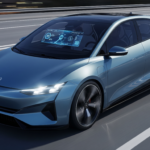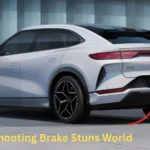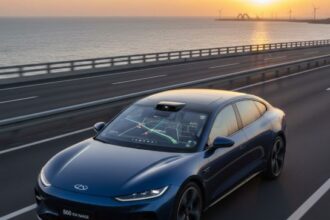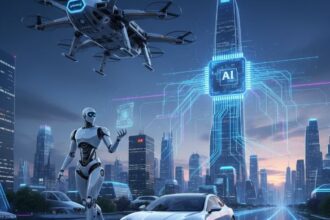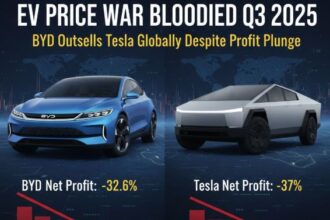
The automotive landscape is rapidly shifting towards electrification, and Hyundai is poised to make a significant impact with its highly anticipated Staria EV. This all-electric multi-purpose vehicle (MPV), or van, is set to redefine expectations for electric mobility, offering a versatile solution for both personal and commercial use. Recent sightings of the Staria EV undergoing testing in South Korea have generated considerable excitement, signaling its imminent arrival and reinforcing Hyundai’s commitment to a sustainable future.
A Design That Electrifies: Functionality Meets Modern Aesthetics
The Hyundai Staria EV stands out with its futuristic and distinctly modern design, a hallmark of the Staria lineup. However, the EV variant incorporates subtle yet crucial modifications that highlight its electric powertrain. Most notably, the traditional front grille, essential for internal combustion engines, is replaced by a sleek, covered panel. This design choice is not merely aesthetic; it’s a functional adaptation to the EV’s reduced cooling requirements, contributing to improved aerodynamics and a more streamlined appearance.
One of the most telling features confirming its all-electric status is the prominent charge port. Unlike plug-in hybrids that feature both a fuel cap and a charging port, the Staria EV’s dedicated charging inlet signifies its reliance solely on electric power. This design decision streamlines the charging process and simplifies the user experience for those transitioning to fully electric vehicles. Furthermore, reports suggest that the rear overhang of the EV model has been subtly reduced compared to its gasoline and diesel counterparts. This seemingly minor adjustment could significantly enhance the vehicle’s maneuverability, especially in urban environments and tight parking spaces, making it an even more practical choice for daily commutes and commercial operations.
Versatility at Its Core: Configurations for Every Need
The Hyundai Staria’s inherent design lends itself beautifully to a multitude of applications, and the EV variant is no exception. Hyundai is expected to offer the Staria EV in a diverse range of configurations to cater to a broad spectrum of consumers and businesses:
- Cargo Version: This variant will be a boon for commercial enterprises requiring a spacious and efficient solution for goods transportation. With zero tailpipe emissions, it offers a sustainable alternative for deliveries and logistics, particularly crucial for urban centers with increasingly stringent emission regulations.
- Passenger Version: Designed with families and group transport in mind, the passenger Staria EV will provide a comfortable and quiet ride for multiple occupants. Its spacious interior and flexible seating arrangements make it an ideal choice for large families, ride-sharing services, or shuttle operations, promising a refined travel experience.
- Camper Version: Perhaps the most exciting and innovative configuration, a camper version of the Staria EV is also anticipated. This opens up new possibilities for eco-conscious adventurers and travel enthusiasts, allowing them to explore nature with a minimal environmental footprint. Imagine silent journeys and emission-free overnight stays, truly redefining the camping experience.
This multi-faceted approach to configurations underscores Hyundai’s ambition to position the Staria EV not just as a vehicle, but as a versatile platform capable of adapting to various lifestyles and business demands.
Powering the Journey: Battery Specifications and Range Expectations
At the heart of any electric vehicle lies its battery, and the Hyundai Staria EV is expected to offer compelling options to suit different range requirements. The video suggests the availability of two primary battery sizes: a 76 kWh and a larger 84 kWh pack. The 84 kWh battery is reportedly a Nickel Manganese Cobalt (NCM) type, with LG Chem potentially being the supplier – a testament to Hyundai’s commitment to high-quality and reliable battery technology.
Range is a critical consideration for prospective EV buyers, and the Staria EV aims to provide competitive figures. Initial projections indicated a range of approximately 350 km (217 miles) for the smaller battery. For the larger 84 kWh battery, estimates hinted at potentially achieving up to 400 km (250 miles). However, it’s worth noting that some segments of the video also mentioned a figure of 324 km for the 84 kWh battery, suggesting that final official figures might vary based on testing cycles and specific configurations. These ranges, while perhaps not class-leading for smaller passenger EVs, are significant for a vehicle of the Staria EV’s size and capability, making it suitable for daily commutes, inter-city travel, and many commercial routes. Real-world conditions, including driving style, cargo load, and temperature, will naturally influence the actual achievable range.
Dimensions: A Spacious Presence on the Road
The Hyundai Staria EV retains the impressive dimensions of its conventional counterparts, ensuring ample interior space and a commanding road presence. Its estimated measurements are:
- Length: 5,233 mm (approximately 207 inches)
- Width: 1,997 mm (approximately 78.66 inches)
- Height: 78.35 inches
These dimensions underscore its capacity to comfortably accommodate multiple passengers or substantial cargo, solidifying its position as a true MPV. For commercial users, these generous dimensions translate directly into increased load capacity and operational efficiency. For families, it means unparalleled comfort and space for long journeys, luggage, and even adventurous gear.
Global Ambitions: Market Availability and Manufacturing Plans
Hyundai has ambitious plans for the Staria EV’s global rollout. The vehicle is expected to launch towards the end of the current year (as of the video’s recording), indicating that its official unveiling and market debut are just around the corner.
Beyond its initial launch, Hyundai is making strategic moves to ensure widespread availability. A significant development mentioned in the video is the plan to commence production of the Staria EV in Europe from the first half of 2026. This local manufacturing presence will not only cater to the strong European demand for electric vehicles but also potentially streamline distribution and reduce logistical costs for the region. The Staria EV is slated for sale across key markets in Europe, Asia, and the Asia Pacific region, specifically mentioning potential availability in countries like Thailand, Malaysia, and Australia, where demand for versatile and sustainable transport solutions is growing. However, its availability in the crucial US market remains uncertain at this time, a point of keen interest for American consumers and businesses.
The Electric Van Arena: Competitive Landscape
The electric van and people mover segment is witnessing burgeoning interest and fierce competition as more manufacturers recognize the immense potential of sustainable commercial and passenger transport. The Hyundai Staria EV will enter a dynamic market, competing against several established and emerging players. The video specifically highlighted some notable rivals, including:
- Geely’s New Electric Van: With a reputation for rapid innovation, Geely’s entry into the electric van segment, particularly with a large battery pack, will undoubtedly pose a significant challenge.
- Xpeng X9: A compelling offering from the Chinese EV manufacturer known for its advanced technology and innovative designs in the passenger vehicle segment, now extending its reach to MPVs.
- Ford E-Tourneo: Ford’s electrified version of its popular Transit and Tourneo Custom models, leveraging its strong commercial vehicle heritage to offer a familiar yet sustainable option.
- Volkswagen ID. Buzz: Volkswagen’s highly anticipated modern take on the iconic Microbus, the ID. Buzz, combines nostalgic charm with cutting-edge electric technology, appealing to a lifestyle-oriented segment.
- LDV Mifa 9: Another strong contender from a rapidly expanding brand, offering a feature-rich and spacious electric MPV.
- Zeekr 009: A luxury electric MPV from Geely’s premium electric mobility technology brand, aiming to redefine comfort and technology in the segment.
This competitive landscape underscores the growing demand for electric vans and MPVs, pushing manufacturers to innovate and offer diverse solutions. The Staria EV will need to differentiate itself through its blend of design, versatility, range, and Hyundai’s reputation for reliability.
The Presenter’s Perspective: Range Anxiety and Market Impact
The video’s presenter offered valuable insights and a candid perspective on the Staria EV. While acknowledging the positive development of increased electric van options, especially for the family and commercial sectors, a recurring concern was raised regarding the vehicle’s expected range. The presenter specifically voiced apprehension that the range might not be sufficient for a significant portion of users, particularly for long road trips where charging infrastructure might be sparse or inconvenient. Personal preference was also shared, with the presenter stating a reluctance to purchase a vehicle with less than 400 km of real-world range, highlighting a common barrier to EV adoption for many consumers.
Interestingly, the video also touched upon the past mention of a potential hydrogen fuel cell version of the Staria, which was planned for 2023 but did not materialize. This detail provides context on Hyundai’s broader exploration of alternative fuels and their ultimate decision to prioritize a battery-electric variant for the Staria platform, likely due to advancements in battery technology and expanding charging infrastructure.
